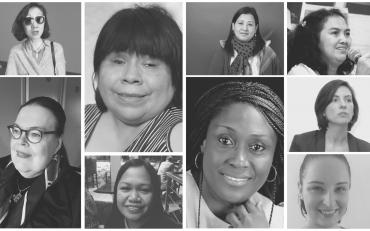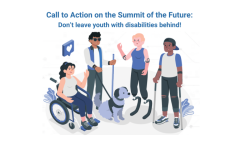This story is part of the "Virtual Event: COVID-19 and Promoting Rights of Women and Girls with Disabilities"
As the COVID-19 pandemic swept across the globe, it has disrupted many planned United Nations (UN) events, conferences, and main functions. Among the suspended events is a sixty-fourth session of the Commission on Status of Women (CSW64). With the rapidly changing pace and unprecedented nature of the pandemic, International Disability Alliance (IDA) and European Disability Forum (EDF) decided to create space to react to this situation and its effect on the lives of women and girls with disabilities.
On April 8, 2020, IDA in collaboration with EDF held a virtual panel bringing together prominent women with disabilities from different walks of life. The virtual panel with 572 registered participants was an effort to provide space and prevent any loss of momentum in promoting the rights of women and girls with disabilities in the global gender equality agenda.
During the virtual discussion, the panelists have discussed various topics ranging from the inclusion of women and girls with disabilities into mainstream gender mainstreaming strategies, multiple forms of discrimination faced by women and girls with various forms of disability, and the impact of the current pandemic on their well-being.
Invisible Women
The panelists stressed that programs addressing gender-based discrimination often cases overlook peculiar issues relating to experiences of women with disabilities. In fact, women with disabilities are rarely included in mainstream gender work. Pratima Gurung, General Secretary of the Indigenous Persons with Disabilities Global Network, pointed out that “The representation of women with disabilities in the disability and in the feminist, movement are taken as a tokenism only for inclusion. Women with disabilities are not meaningfully included. Our voices are not taken meaningfully.” An absence of inclusive strategies continues to perpetuate the invisibility of women with disabilities from development discourse and larger public policies.
Double Discrimination
The panelists univocally stressed that there is no serious strategy that has yet been implemented to tackle multiple forms of discrimination that women with disabilities experience. Women and girls with disabilities face double discrimination on the grounds of sex and disability. Villaney Remengesau from the Pacific Disability Forum said, “This is true, women and girls with disabilities face multiple and intersectional discrimination. Although there is limited availability of disability and gender-disaggregated data, the evidence points to significantly greater inequality experienced by women and girls with disabilities compared to other women and girls, men and boys with disabilities”. The double discrimination found at the societal level prevents discussion of issues important to women and girls with disabilities and leads to policies and programs that are not inclusive of their perspectives and needs.
Lack of Accessible Information
At the onset of the COVID-19 pandemic, governments and media fall short in providing accessible information (e.g, sign language, easy-to-read, captions, etc.) on coronavirus and protection measures. Judith Ekate, a Board Member of the African Disability Forum and prominent advocate for the rights of women with disabilities from Nigeria, expressed that “The response to COVID-19 so far, aside the provision of sign language interpreters at the press briefing, onsite services for the isolation and treatment centers do not in any way take into consideration the needs of women with disabilities that might be using such facilities". Yeni Rosa Damayanti, Chairperson of the Indonesian Mental Health Association, added that the conditions in mental institutions are even worse. In the words of Yeni Rosa, mental institutions do not consider women with psychosocial disabilities are capable of thinking. “Almost all of them do not have access to information. There are no phones, no Internet, no media, no television, they're cut off from the rest of the world and they're lacking in the information of COVID- 19”, says Yeni Rosa.
The exclusion and discrimination found at the societal, programs, and policy levels also transmitted into the COVID-19 pandemic response. Women and girls with disabilities may have increased risk for exposure to and complications from coronavirus. Villaney Remengesau said: “Most women and girls with disabilities are for and living in overpopulated areas with poor living conditions. This exacerbates their exposure to the outbreak and their invisibility makes it hard to put in place measures to respond to the outbreak and decrease the risk of their vulnerability.”
Unanimously, the panelists urged that it is pivotal for governments to ensure that women with disabilities are not discriminated against. They further called on governments to provide accessibility for critical information to guide people with disabilities in taking necessary precautions, identify where to seek help, and who to contact in case of emergency.
Missing Voices of the COVID-19 Pandemic
The panelists called governmental and non-governmental organizations to stop homogenizing the experiences of women with disabilities. Pratima Gurung, a representative of indigenous people with disabilities, explained that the policies at the national level use either the gender or disability lenses, completely ignoring the intersectionality lens. “The policies, even at the emergency situation, are the same policies that were existed from the past. So, when they look at the situation through the gender lens, women with disabilities are being left behind; when they look through the disability framework, underrepresented groups like indigenous women with disabilities are left behind”, says Pratima Gurung. The dearth of intersectional both in policies and COVID-19 mitigation strategies, according to the panelists, is the major reason for the lack of collective and inclusive response to the pandemic mitigation.
Lack of intersectional lens and homogenization of women with disabilities' experiences are evident in the media coverage of the COVID-19 pandemic and rise of domestic violence, which omits the experience of women with disabilities. This is despite the fact that women with disabilities are at greater risk of violence than those without disabilities. For instance, in the United States alone violence against people with disabilities has been reported to be 4–10 times greater than that against people without disabilities. In other words, women with disabilities significantly more likely to experience intimate partner violence (IPV) as compared with those without disabilities (33.2% and 21.2%, respectively). In spite of stark differences in data, the experiences of women with various forms of disabilities amidst global lockdown, and the rise in domestic violence are being grossly neglected.
Amanda McRae, Director of U.N. Advocacy at Women Enabled International, reports that the invisibility of women and girls with disabilities is particularly startling despite the fact that they represent more than half of all persons with disabilities worldwide and almost 20% of all women worldwide. Yeni Rosa Damayanti, Chairperson of the Indonesian Mental Health Association, reminds that women and girls with intellectual disabilities are particularly vulnerable to sexual violence. “Even prior to the COVID-19 pandemic, there are a lot of sexual abuses and sexual harassment and forced sterilization happening in the institution”, cautions Yeni Rosa Damayanti. Despite these concerning facts, there is an acute silence in media and by policymakers about the IPV against women and girls with various forms of disabilities amidst the COVID-19 lockdown.

